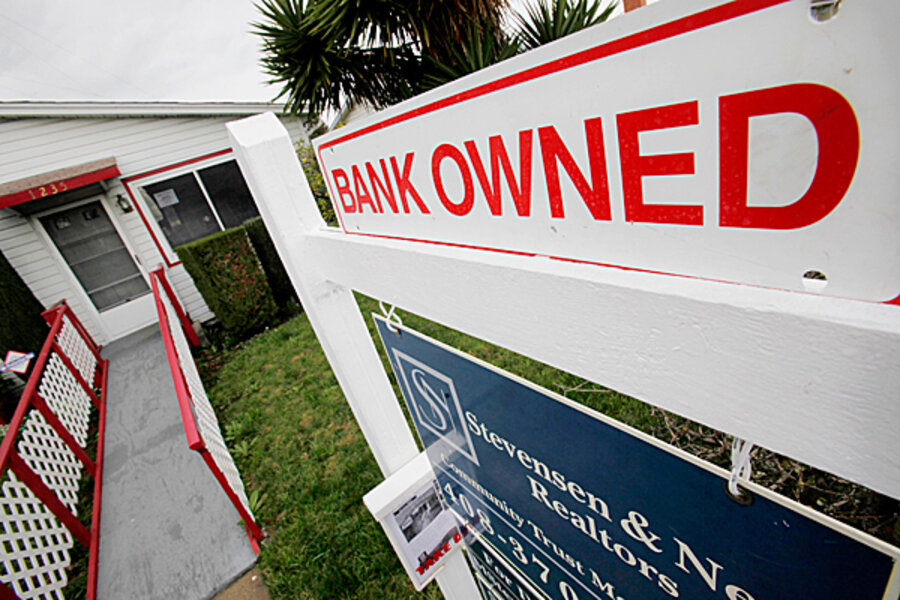Obama wields new tools to try, again, to stem home foreclosures
Loading...
In a bid to meet its home foreclosure-prevention targets, the Obama administration is offering new incentives for lenders to reduce loan balances for at-risk borrowers.
The program addresses a fundamental problem in the housing market: Because of falling home values, millions of borrowers now owe more than their homes are worth – with many so far "under water" that default and foreclosure are likely.
The Obama administration effort offers several new programs for borrowers in distress:
• Many lenders, in weighing options for distressed homeowners, are being required to consider writing down the principal balance on a mortgage. Although these lenders won't reduce the principal in every case, they will have new incentives to opt for those write-downs.
• Some borrowers will be able to shift from their current mortgages into refinance loans arranged through the Federal Housing Administration. To mitigate the "under water" problem, the FHA's refinance loans will be given only when principal write-downs bring a loan balance down to 115 percent of a home's current value or less. Also, the new loan must cost no more than 31 percent of a borrower's income. Often both a first-lien and second-lien lender will take losses as the loan is refinanced, but they may fare better than if they went forward with foreclosure.
• Loan servicers who participate in the federal government's Making Home Affordable Program are required to offer a three-month forbearance period for borrowers who become unemployed. For three months, qualifying borrowers will have to spend no more than 31 percent of their income on their mortgages – even if that amount is lower than their usual payments.
• For loans that still head toward foreclosure, the government will provide new incentives to encourage loan servicers and the holders of subordinate liens to opt for foreclosure alternatives. More borrowers would be able to do a "short" sale (selling their homes for an amount below their loan balances) or transfer ownership through the process called "deed in lieu of foreclosure."
Target: Save at least 3 million homeowners from foreclosure
"We can make a material difference" in the housing market with these programs, Diana Farrell, a top economic adviser to Obama, said in a press briefing Friday as the details were announced. She said the steps should enable the administration to reach its target of keeping 3 million to 4 million home loans out of foreclosure.
But she said many borrowers have mortgages so troubled they cannot be saved, even with the new help. In addition, homeowner rescue programs face a fairness test in the public eye. The Obama administration has been targeting its relief – including its latest programs – toward "responsible" borrowers who are not wealthy. Housing speculators or people with jumbo-size loans do not qualify for help.
The latest efforts come as foreclosure-relief efforts so far have failed to match White House goals. It also comes as a tide of foreclosures threatens to cause another move down for house prices in the US – which could hurt consumer confidence and the job market.
Banks unwilling to write down balances
So far, few banks and mortgage lenders have agreed to write down the principal balances on large numbers of at-risk loans. Instead, they have tried to prevent defaults by modifying loans so that monthly payments are reduced. Often the borrowers default even on the modified loans.
That may be changing, as banks weigh their losses from principal reductions against the losses they'd face by foreclosing. This week Bank of America launched its own program to write down balances on loans that are deeply under water. The latest White House plans could give an extra nudge to accelerate this trend.
In a report this week, First American Corelogic estimates that 11.3 million residential properties with mortgages (24 percent of the total) had negative equity at the end of the fourth quarter of 2009. It may take five to 10 years, the company predicts, for many of these borrowers to build a positive equity position in their homes.
The new relief efforts seek "a tricky balance," Ms. Farrell said. The goal is to support an economic recovery by reducing preventable foreclosures, but to "do no more than is responsible to do."
The program exposes US taxpayers to some risk. The various incentives will draw on $50 billion in Treasury funds. That money, in the Troubled Asset Relief Fund, was already allocated for housing-market relief last year. Some of the money will go toward incentives for lenders and borrowers. Other money will go toward backstopping the FHA as it takes new risks refinancing troubled loans – which may end up in default even after the FHA-assisted writedown of principal.
Here are Obama administration news releases detailing the FHA refinance loans, new help for the unemployed and other borrowers, and "frequently asked questions" on the programs.





